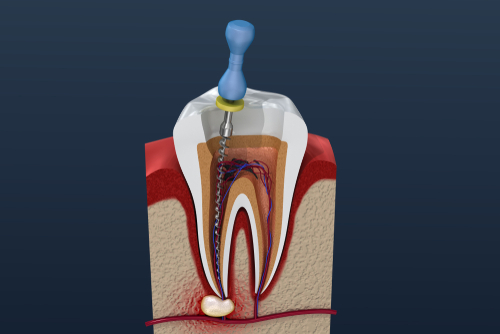Root Canal Therapy for a Painless Smile Makeover!
 Are you tired of hiding your smile because of persistent dental pain? Do you dream of a painless and beautiful smile makeover that will help you regain your confidence and quality of life? At Tuckerton Dental, our experienced Tuckerton, NJ dentist, Dr. Ronald Petrosky offers root canal therapy. Root canal therapy is a miraculous dental procedure that not only relieves excruciating toothaches but also serves as the key to unlocking the radiant, pain-free smile you’ve always desired.
Are you tired of hiding your smile because of persistent dental pain? Do you dream of a painless and beautiful smile makeover that will help you regain your confidence and quality of life? At Tuckerton Dental, our experienced Tuckerton, NJ dentist, Dr. Ronald Petrosky offers root canal therapy. Root canal therapy is a miraculous dental procedure that not only relieves excruciating toothaches but also serves as the key to unlocking the radiant, pain-free smile you’ve always desired.
If you’re experiencing signs of a severely damaged or infected tooth that may require a root canal, contact us today by giving Dr. Petrosky a call at (609) 296-1007.
What Is a Root Canal?
A root canal is a procedure to repair and save a tooth that has become badly damaged or infected. During a root canal, your dentist will remove the infected or dead pulp from inside the tooth roots and seal the area to prevent further damage. With proper aftercare, a root canal can help restore functionality and keep natural teeth for many more years.
Benefits of Root Canal Therapy
- Pain Relief: Root canal treatment helps alleviate severe toothache and discomfort caused by infected or damaged pulp inside the tooth.
- Preservation of Natural Teeth: It allows you to keep your natural tooth instead of having it extracted, which helps maintain proper dental function and aesthetics.
- Improved Oral Health: By removing the infected pulp and cleaning the tooth’s interior, root canal treatment prevents the spread of infection to other teeth and reduces the risk of oral health complications.
- Efficient Chewing: Restoring the tooth’s function allows you to chew and bite normally, improving your ability to enjoy a varied diet.
- Cost-Effective: Root canal therapy is generally more cost-effective than extracting a tooth and replacing it with a dental implant or bridge.
- Long-Lasting Results: A well-performed root canal can provide a durable solution, potentially lasting a lifetime with proper care.
Reasons for Needing a Root Canal
There are several common reasons why someone may require a root canal procedure:
Deep Decay

Extensive decay that has reached deep inside the tooth, infecting or killing the inner pulp tissue, often requires a root canal. Our Dentists will recommend a root canal if the decay is too deep to treat with a simple dental filling.
Cracked or Broken Teeth
Cracks or fractures that extend below the gumline into the roots can allow bacteria to infect the pulp. Root canals ar
e frequently needed for cracked teeth to clean out the infected tooth pulp and save the remaining tooth structure.
Repeated Dental Procedures
Multiple fillings, prior root canals, or other restorative work on a tooth can eventually cause the inner pulp to become irritated and inflamed. A root canal may be required to treat the subsequent infection.
Injury or Trauma to the Tooth
A severe blow or injury that fractures roots or dislocates the tooth may damage the pulp and require root canal therapy to prevent further infection.
Root Canal Procedure
The steps involved in a root canal procedure include:
Numb the Area with Local Anesthetic
Your dentist will administer a local anesthetic to fully numb the area around the affected tooth. You shouldn’t feel any pain during the procedure.
Drill an Opening Through the Top of the Tooth
A small hole is made through the top of the tooth to reach the pulp chamber and root canals. Your dentist will use specialized dental instruments to gently remove the pulp.
Remove Infected or Dead Pulp
All of the infected or dead pulp is carefully cleaned out of the inner root canals. This is one of the most important steps to root canal treatments to eliminate bacteria and prevent further infection.
Clean and Shape the Inside of the Tooth Roots
Small specialized instruments will be used to thoroughly shape and clean the entire length of the root canals. This prepares the canals to be sealed.
Fill and Seal the Roots with Gutta-Percha Material
Once cleaned, shaped, and disinfected, the empty root canals are filled and sealed with an inert rubbery material called gutta-percha. This prevents recontamination of the roots.
Place a Crown or Filling to Restore the Tooth
After the root canals are sealed, the tooth will be restored with a filling or dental crown to protect it and improve its appearance. The restored tooth can often last a lifetime with proper care.
Frequently Asked Questions
It is normal to experience some mild soreness or tenderness for a few days after having a root canal. Over-the-counter pain medication can provide relief. However, you should not feel intense pain – let your dentist know if symptoms persist.
In a small percentage of cases, root canals can fail over time due to reinfection or complications. This may require a repeat root canal or extraction if the tooth cannot be saved. With good oral hygiene and follow-up care, a properly done root canal has a very high long-term success rate.
Most patients can return to their normal routine immediately after the root canal is completed. Recovery from a dental procedure typically takes one to two days, during which the tooth may be sensitive. After two to three weeks, healing is usually sufficient to resume normal chewing on the tooth.
Often a crown is recommended after a root canal to fully protect and restore the tooth. The crown covers and seals the tooth from fractures or re-infection. Alternatively, a temporary filling may be sufficient depending on the location and amount of remaining tooth structure.
Revitalize Your Smile with Root Canal Therapy!
If you’re experiencing persistent tooth discomfort or suspect the need for a root canal, don’t hesitate to consult with your skilled Tuckerton, NJ dentist. Taking action promptly can lead to a pain-free, functional smile that lasts a lifetime. Schedule a consultation today and take the first step towards a healthier, happier mouth. Your future self will thank you!